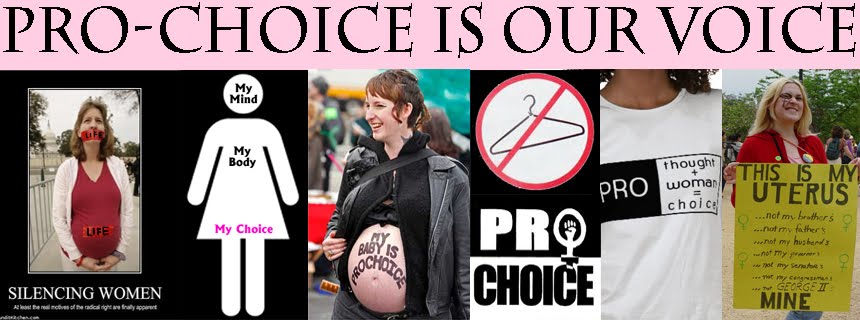I read another article that examines the rhetoric and legislative strategy of pro-life: that they've altered the presentation of their position "from one that pits fetal rights against maternal rights, to one that emphasizes the unique and intimate bond between the woman and the 'child'" (Halva-Neubauer 101). I've mentioned this before, that when I look at pro-life propaganda and legislation, I'm always struck by the way they portray the fetus as a baby, not as something that will grow into a baby. As Halva-Neubauer and Zeigler say, they portray "the fetus as a living infant in other legal contexts, and [emphasize] what anti-abortion activists characterize as the painful, brutal, and inhumane nature of the abortion procedure and those who perform it" (102). As a visual rhetoric tool, "groups that do not focus primarily on abortion also advance the case for fetal personhood by employing imagery that portrays the fetus as a baby" (109).
It's much harder to make a case for fetal personhood when the rights of the fetus do not line up with the rights of the mother--when the rights of the fetus may, in fact, at times oppose the rights of the mother. But "the assertion that the interests of the fetus and the interests of the pregnant woman necessarily coincide represents and important development in pro-life advocacy work;" a development that makes it a lot harder to separate a pregnant woman from her unborn child (Halva-Neubauer 102). It's also a lot easier to argue for the rights of a person--which is why the pro-life side is arguing so hard for fetal personhood: "Pro-life activists adopt the view that abortion ends a human life and have consistently advanced the principle that the practice should be stopped, just like any other form of unjustified killing" (102).
Another part of the rhetoric strategy involves carrying the baby to term being presented as the best option for the woman. "Not only does the issue [of limiting reproductive choice] implicate control of women's sexuality, but it also reaches to the very definition of human life. [...] pro-life groups integrate the language of duty, morality, and women's traditional (and religious) role as mother" (107). In another blog entry, I mentioned a Tea Party candidate who saw abortion as "woman abuse"--this standpoint that abortion is bad for women is one that the pro-life movement has been taking more recently. Halva-Nebauer and Zeigler see it as a "shift from portraying the pregnant woman as the enemy to the woman as someone who has an intimate connection to the life within her, who requires education at worst and who can serve as an advocate for the fetus at best" (108).
The other way pro-life and anti-abortion activists created a strategy to argue for fetal personhood involved the assertion that a fetus can feel pain. Though this is hotly contested among scientists and activists alike, a film called The Silent Scream which was released in 1984 shows "a sonogram of a suction abortion at twelve weeks [...] when the fetus opens its mouth, apparently reacting to the fact that the suction pipe has located its body" (Halva-Neubauer 104-105). Regardless of whether or not this film proves that a fetus can feel pain, the image of a fetus being aborted cannot be easy to watch, even for the most adamant of pro-choice people. (When I was researching for this blog, I came across images of aborted fetuses, and they're haunting and disgusting, and a powerful tool to manipulate the emotions of people who are uncertain of where they stand on the issue).
One last thing the article talks about that really struck me is their "Statutory Analysis" near the end. "The statutory strategies portraying the fetus as an infant take numerous forms, though they fall into two categories. The first includes legislative measures that seek to establish legal personhood. These include fetal homicide laws, as well as more subtle variants of personhood, such as those requiring abortion clinics to show ultrasound images of the fetus to the woman prior to performing an abortion and providing benefits to the unborn [...]. The second category of laws addresses the purported brutality and cruelty of abortion, with particular emphasis on late-term procedures, when the fetus is most likely to resemble an infant. These laws regulate specific abortion procedures, relying on the imagery of dismemberment to convey the message that a baby is being destroyed by the procedure. They also require that the health-care provider inform the woman that the fetus may experience pain during the procedure (a heavily disputed point) and to offer the option of fetal anesthesia" (112). It is also worthwhile to note that on the subject of fetal pain, "abortion-rights advocates counter that the fetus does not feel pain, and that the sole purpose of the legislation [that involves requiring physicians to tell women that the fetus may feel pain and to offer fetal anesthesia] is to increase the cost of the abortion procedure" (105).
The most interesting thing about all of this, in my opinion, is that this pro-life strategy seems to be arguing that they're actually not limiting the rights of women at all, since they're so adamant that women have a connection with the fetus inside of them, and that it's harmful to women to get an abortion. Is that a fair assumption to make? Can a group of people really tell an individual woman what is best for her, when they know nothing about her?
Source:
Promoting Fetal Personhood: The Rhetorical and Legislative Strategies of the Pro-Life Movement after Planned Parenthood v. Casey. By: Halva-Neubauer, Glen A.; Zeigler, Sara L.. Feminist Formations, Summer2010, Vol. 22 Issue 2, p101-123, 23p
--Alexandra

No comments:
Post a Comment